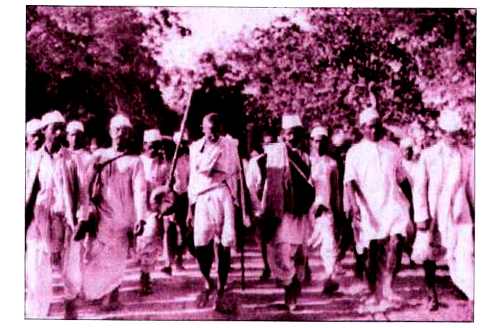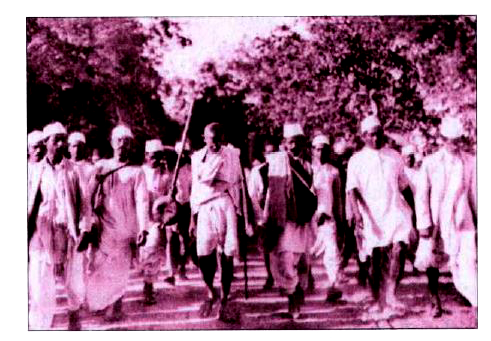In 1930 Mahatma Gandhi's demands were rejected by the British, as a result of which he launched the Civil Disobedience Movement. In this context explain the following:
Name the famous march undertaken by Gandhiji. Where did he begin this march ? State two of its features.

On 12th March, Mahatma Gandhi began the historic march known as the ‘Dandi March’ from Sabarmati Ashram to Dandi, a village on the Gujrat seacoast. A number of people followed him. On the morning of 6" April, 1930, Gandhiji violated the Salt Law at Dandi by picking up some salt left by the sea waves. Two features of Dandi March are :
Gandhi Ji attacked the Salt Law because salttax affected all sections of the society, especially the poor.
The breaking of Salt Law by Gandhi Ji marked the beginning of the Civil Disobedience Movement.
Similar Questions
In 1930 Mahatma Gandhi's demands were rejected by the British, as a result of which he launched the Civil Disobedience Movement. In this context explain the following:
Significance of the Second Round Table Conference

View SolutionIn 1930 Mahatma Gandhi's demands were rejected by the British, as a result of which he launched the Civil Disobedience Movement. In this context explain the following:
The Gandhi-Irwin Pact as a consequence of this Movement.

View Solution
Knowledge Check
In which one of the following states of India is Dandi seashore located where Mahatma Gandhi did his famous march before independence?
AAndhra PradeshBKarnatakaCMaharashtraDGujaratAnalyze the information given below, considering one of the following correct options:
Mahatma Gandhi's letter was, in a way, an ultimatum. If the demands were not fulfilled by 11 March, the letter stated, the Congress would launch a civil disobedience campaign. Irwin was unwilling to negotiate. So Mahatma Gandhi started his famous salt march accompanied by 78 of his trusted volunteers. The march was over 240 miles, from Gandhiji's ashram in Sabarmati to the Gujarati coastal town of Dandi. The volunteers walked for 24 days, about 10 miles a day. Thousands came to hear Mahatma Gandhi wherever he stopped, and he told them what he meant by Swaraj and urged them to peacefully defy the British. On 6 April he reached Dandi, and ceremonially violated the law, manufacturing salt by boiling sea water.ANon-Cooperation MovementBSalt MarchCKhilafat MovementDRowlatt ActRead the passage given and answer the questions that follow:
On 31 January 1930, Mahatma Gandhi sent a letter to Viceroy Irwin stating and imposing eleven demands. Among all the demands, the most stirring of all the demands was to abolish the salt tax that is consumed by the rich and the poor. The demands were needed to be fulfilled by 11 March or else the Congress will initiate a civil disobedience campaign. The popular salt march was started by Mahatma Gandhi and it was accompanied by 78 of his trusted volunteers. The march covered over 240 miles, from Gandhi's ashram in a place called Sabarmati to the Gujarati coastal town of Dandi. On 6 April he reached Dandi, and ceremonially violated the law, and started manufacturing salt by boiling seawater. This movement marked the beginning of the Civil Disobedience Movement
Which of the following statements are not true regarding the Gandhi-Irwin Pact of 1931?AGandhiji decided to call off the Civil Disobedience Movement.BGandhiji consented to participate in the First Round Table Conference.CThe British government agreed to release the political prisoners.DThe British government agreed to grant independence.
Read the passage given and answer the questions that follow:
On 31 January 1930, Mahatma Gandhi sent a letter to Viceroy Irwin stating and imposing eleven demands. Among all the demands, the most stirring of all the demands was to abolish the salt tax that is consumed by the rich and the poor. The demands were needed to be fulfilled by 11 March or else the Congress will initiate a civil disobedience campaign. The popular salt march was started by Mahatma Gandhi and it was accompanied by 78 of his trusted volunteers. The march covered over 240 miles, from Gandhi's ashram in a place called Sabarmati to the Gujarati coastal town of Dandi. On 6 April he reached Dandi, and ceremonially violated the law, and started manufacturing salt by boiling seawater. This movement marked the beginning of the Civil Disobedience Movement
Identify the programmes of the Civil Disobedience Movement.
View SolutionRead the passage given and answer the questions that follow:
On 31 January 1930, Mahatma Gandhi sent a letter to Viceroy Irwin stating and imposing eleven demands. Among all the demands, the most stirring of all the demands was to abolish the salt tax that is consumed by the rich and the poor. The demands were needed to be fulfilled by 11 March or else the Congress will initiate a civil disobedience campaign. The popular salt march was started by Mahatma Gandhi and it was accompanied by 78 of his trusted volunteers. The march covered over 240 miles, from Gandhi's ashram in a place called Sabarmati to the Gujarati coastal town of Dandi. On 6 April he reached Dandi, and ceremonially violated the law, and started manufacturing salt by boiling seawater. This movement marked the beginning of the Civil Disobedience Movement
Which one of the following movement began with the Dandi March?
View SolutionRead the passage given and answer the questions that follow:
On 31 January 1930, Mahatma Gandhi sent a letter to Viceroy Irwin stating and imposing eleven demands. Among all the demands, the most stirring of all the demands was to abolish the salt tax that is consumed by the rich and the poor. The demands were needed to be fulfilled by 11 March or else the Congress will initiate a civil disobedience campaign. The popular salt march was started by Mahatma Gandhi and it was accompanied by 78 of his trusted volunteers. The march covered over 240 miles, from Gandhi's ashram in a place called Sabarmati to the Gujarati coastal town of Dandi. On 6 April he reached Dandi, and ceremonially violated the law, and started manufacturing salt by boiling seawater. This movement marked the beginning of the Civil Disobedience Movement
How much distance covered by M. K. Gandhi during Dandi March?
View SolutionHe wasn't the first, nor would he be the last, but the wiry, bespectacled man from Gujarat is certainly the most famous of the world's peaceful political dissidents.
Mohandas Gandhi – also affectionately known as Mahatma – led India's independence movement in the 1930s and 40s by speaking softly without carrying much of a big stick, facing down the British colonialists with stirring speeches and non-violent protest. More than anything else, historians say, Gandhi proved that one man has the power to take on an empire, using both ethics and intelligence.
Urges Britain to quit India It is hard to imagine the thin, robed Gandhi working in the rough and tumble world of law, but Gandhi did get his start in politics as a lawyer in South Africa, where he supported the local Indian community's struggle for civil rights. Returning to India in 1915, he carried over his desire to improve the situation of the lower classes.
Gandhi quickly became a leader within the Indian National Congress, a growing political party supporting independence, and traveled widely with the party to learn about the local struggles of various Indian communities
It was during those travels that his legend grew among the Indian people, historians say.
Gandhi was known as much for his wit and intelligence as for his piety. When he was arrested several more times over the years for his actions during the movement, Gandhi calmly fasted in prison, believing that his death would embarrass the British enough to spur independence, which had become the focus of his politics by 1920.
Gandhi's non-cooperation movement, kicked off in the early 1920s, called for Indians to boycott British goods and traditions and become self-reliant. His most famous protest came in 1930, when Gandhi led thousands of Indians on a 250-mile march to a coastal town to produce salt, on which the British had a monopoly.
What led to the growth of legend of Mahatma Gandhi among the Indians?
View SolutionRead the passage carefully and select the best answer to question out of the given four alternatives.
PASSAGE - III
He wasn.t the first, nor would he be the last, but the wiry, be spectacled man from Gujarat is certainly the most famous of the world.s peaceful political dissidents.
Mohandas Gandhi - also affectionately known as Mahatma-led India.s independence movement in the 1930s and 40s by speaking softly without carrying much of a big stick, facing down the British colonialists with stirring speeches and non-violent protest. More than anything else, historians say, Gandhi proved that one man has the power to take on an empire, using both ethics and intelligence.
Urges Britain to quit India
It is hard to imagine the thin, robed Gandhi working in the rough and tumble world of law, but Gandhi did get his start in politics as a lawyer in South Africa, where he supported the local Indian community.s struggle for civil rights. Returning to India in 1915, he carried over his desire to improve the situation of the lower classes.
Gandhi quickly became a leader within the Indian National Congress, a growing political party supporting independence, and travelled widely with the party to learn about the local struggles of various Indian communities.
It was during those travels that his legend grew among the Indian people, historians say.
Gandhi was known as much for his wit and intelligence as for his piety. When he was arrested several more times over the years for his actions during the movement, Gandhi calmly fasted in prison, believing that his death would embarrass the British enough to spur independence, which had become the focus of his politics by 1920.
Gandhi.s non-cooperation movement, kicked off in the early 1920s, called for Indians to boycott British goods and traditions and become self-reliant. His most famous protest came in 1930, when Gandhi led thousands of Indians on a 250- mile march to a coastal town to produce salt, on which the British had a monopoly.
What led to the growth of legend of Mahatma Gandhi among the Indians?
View Solution
